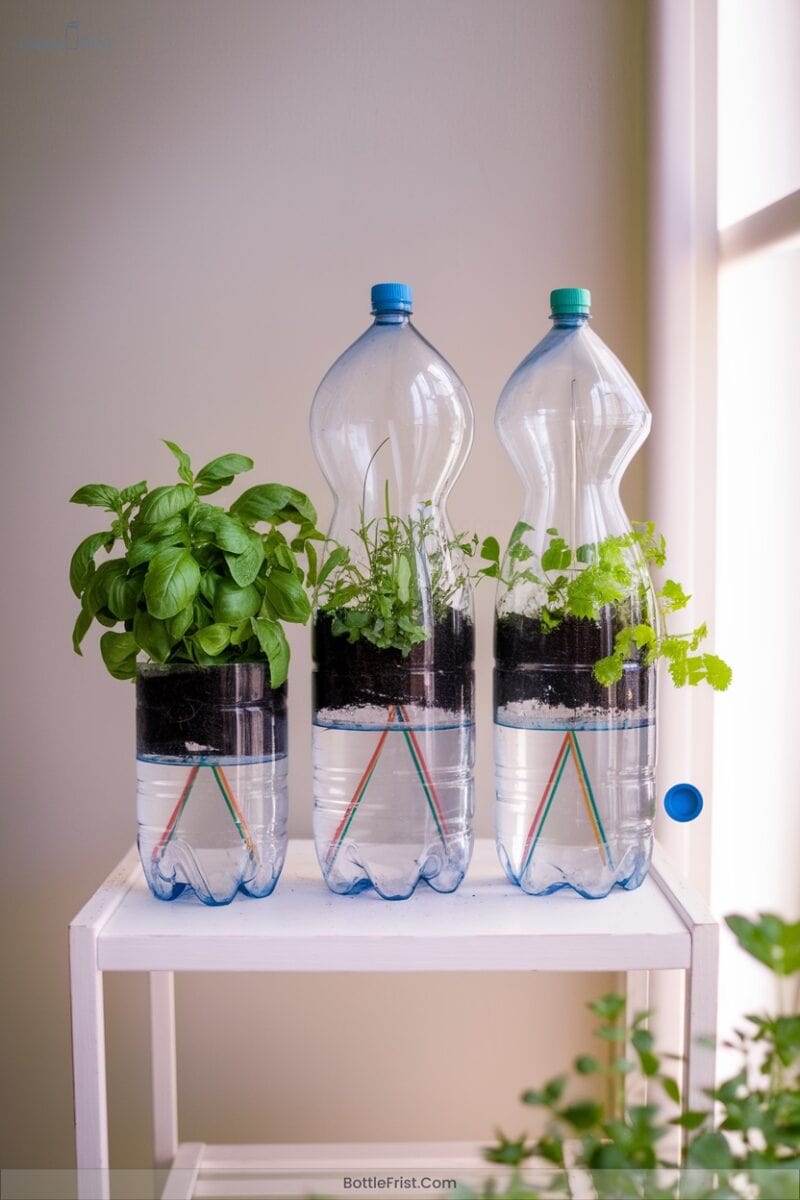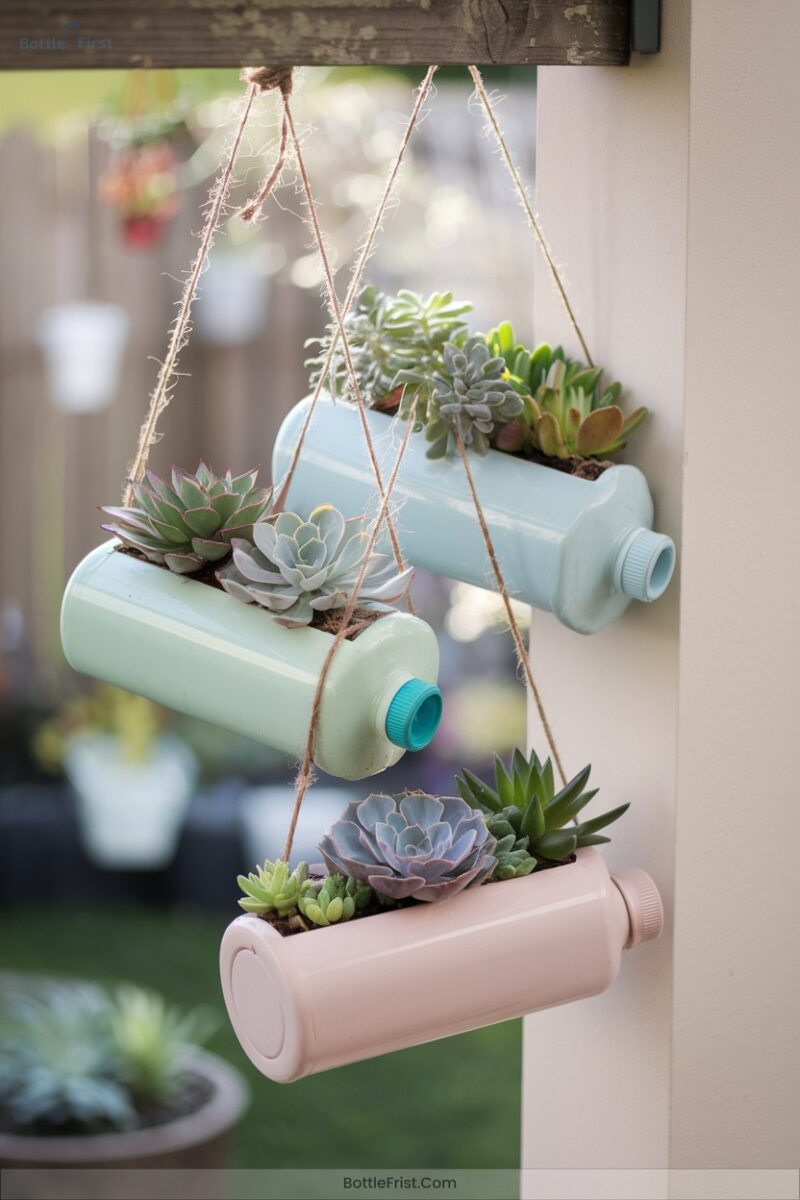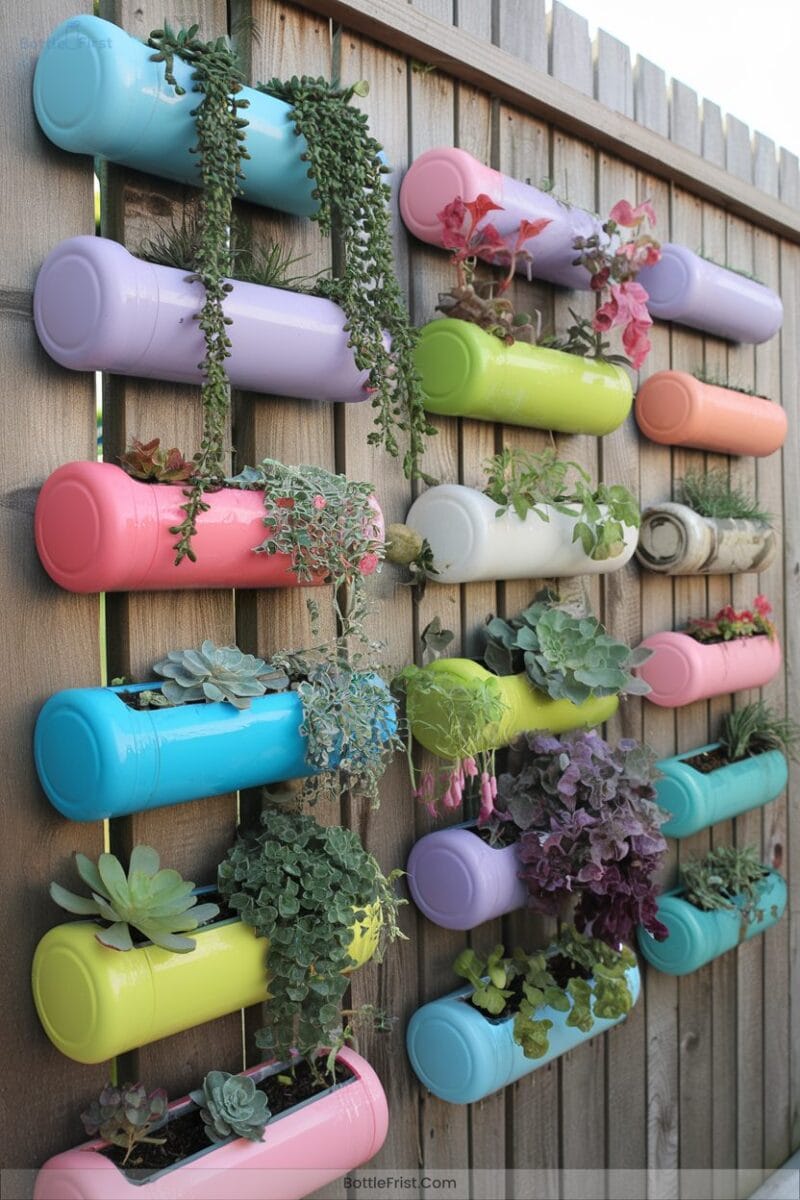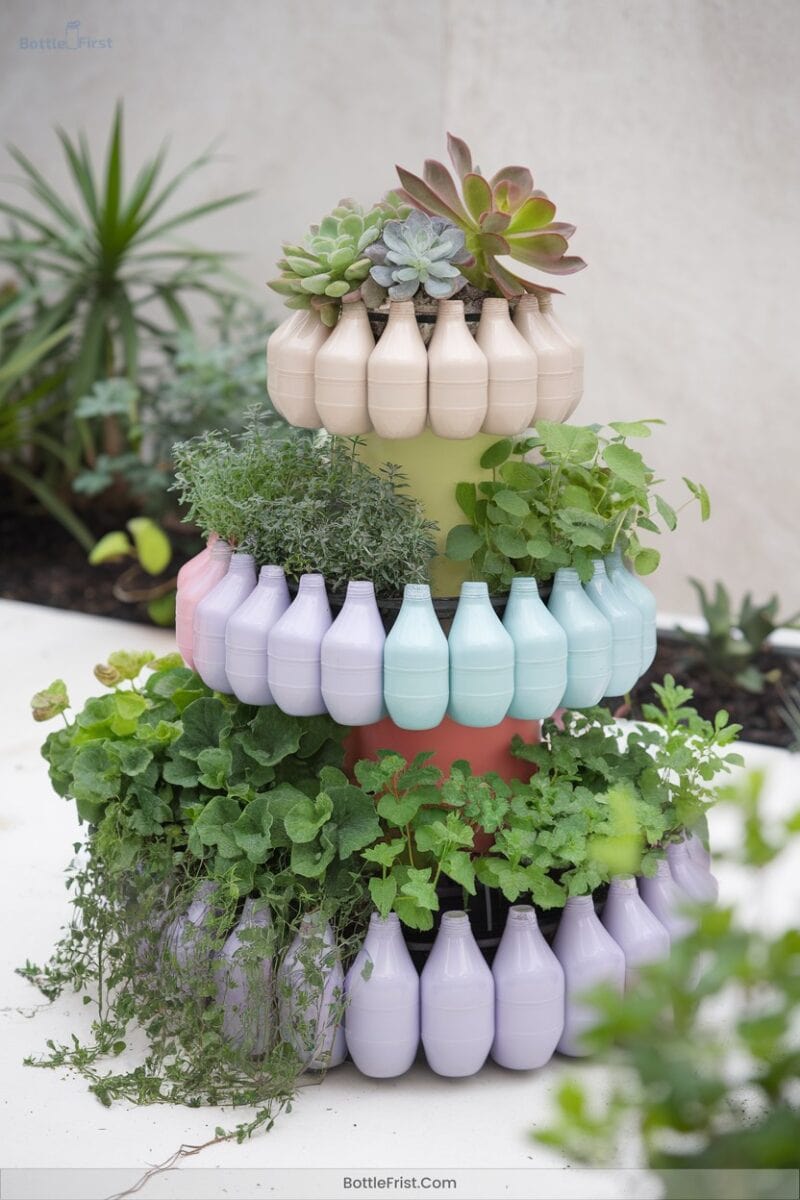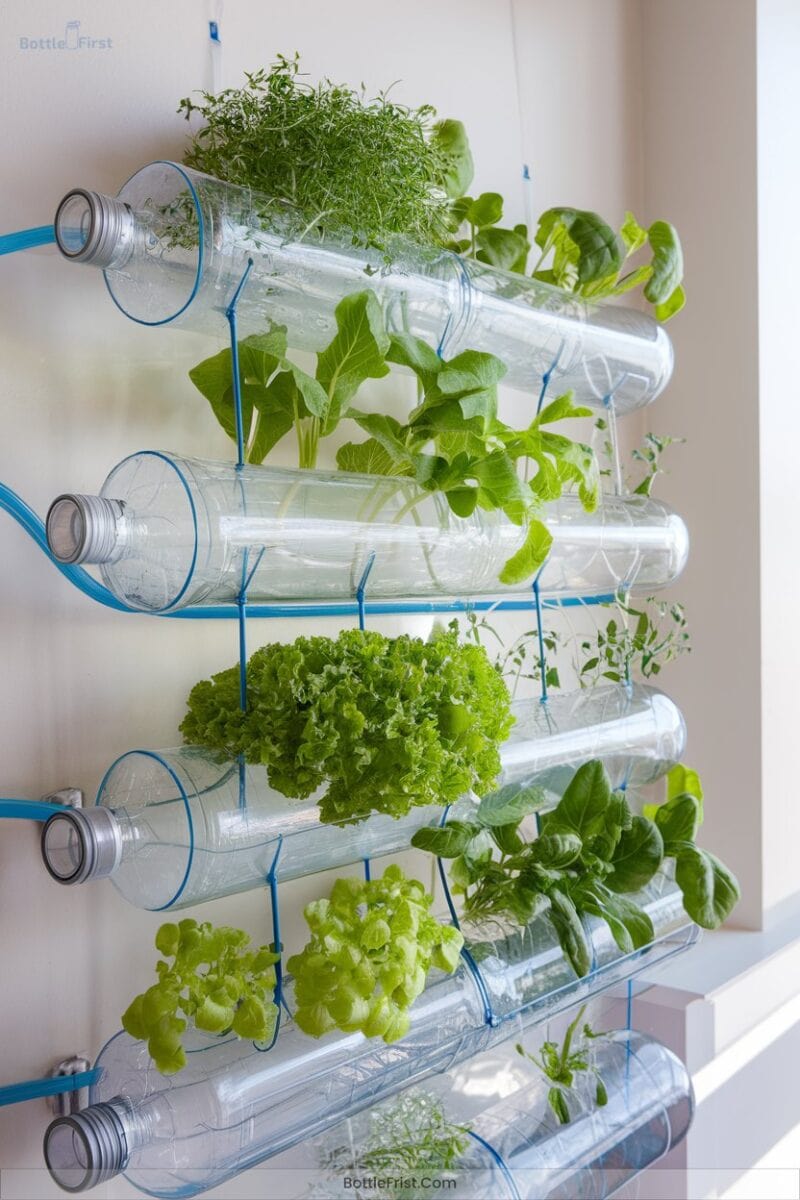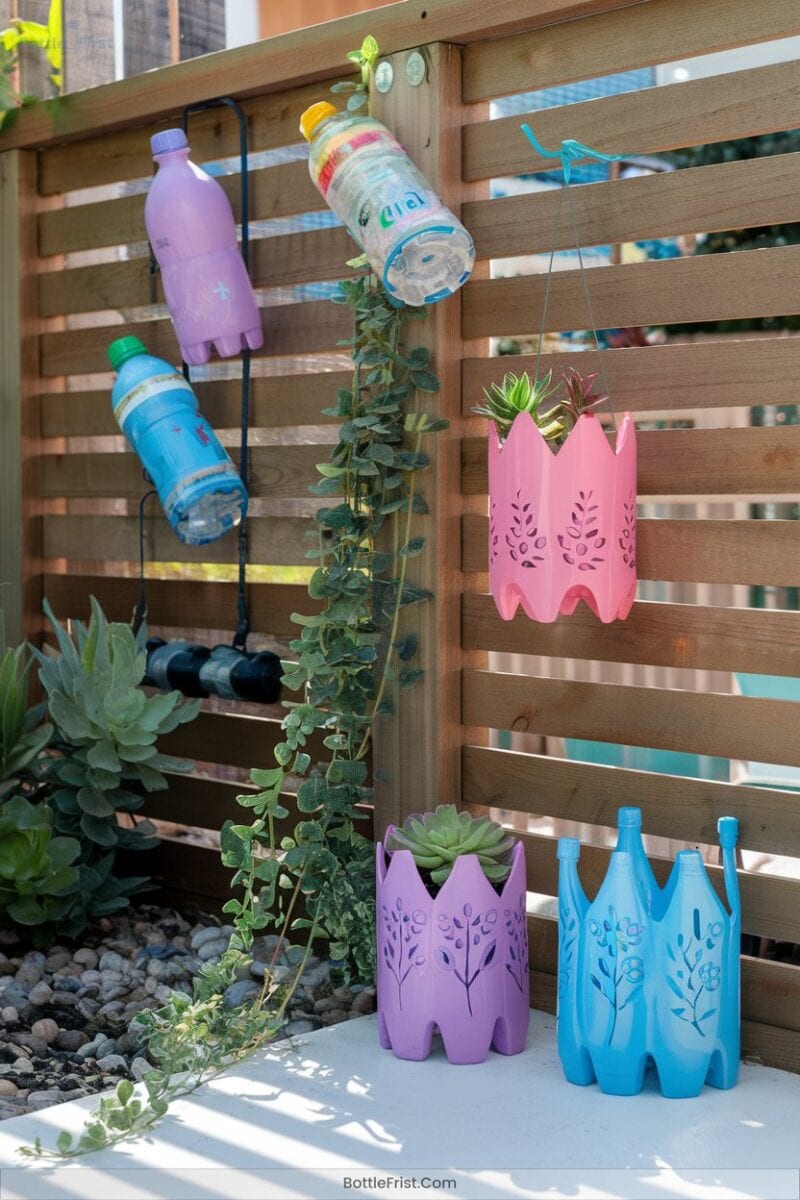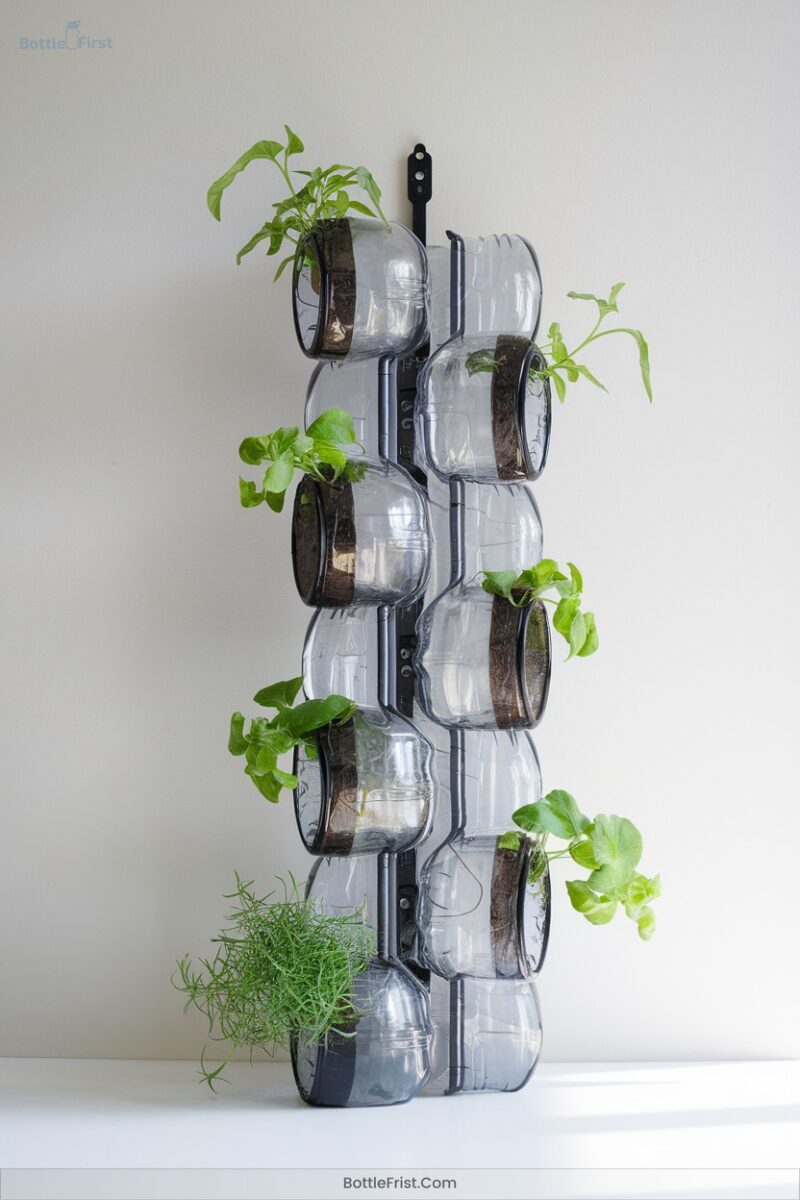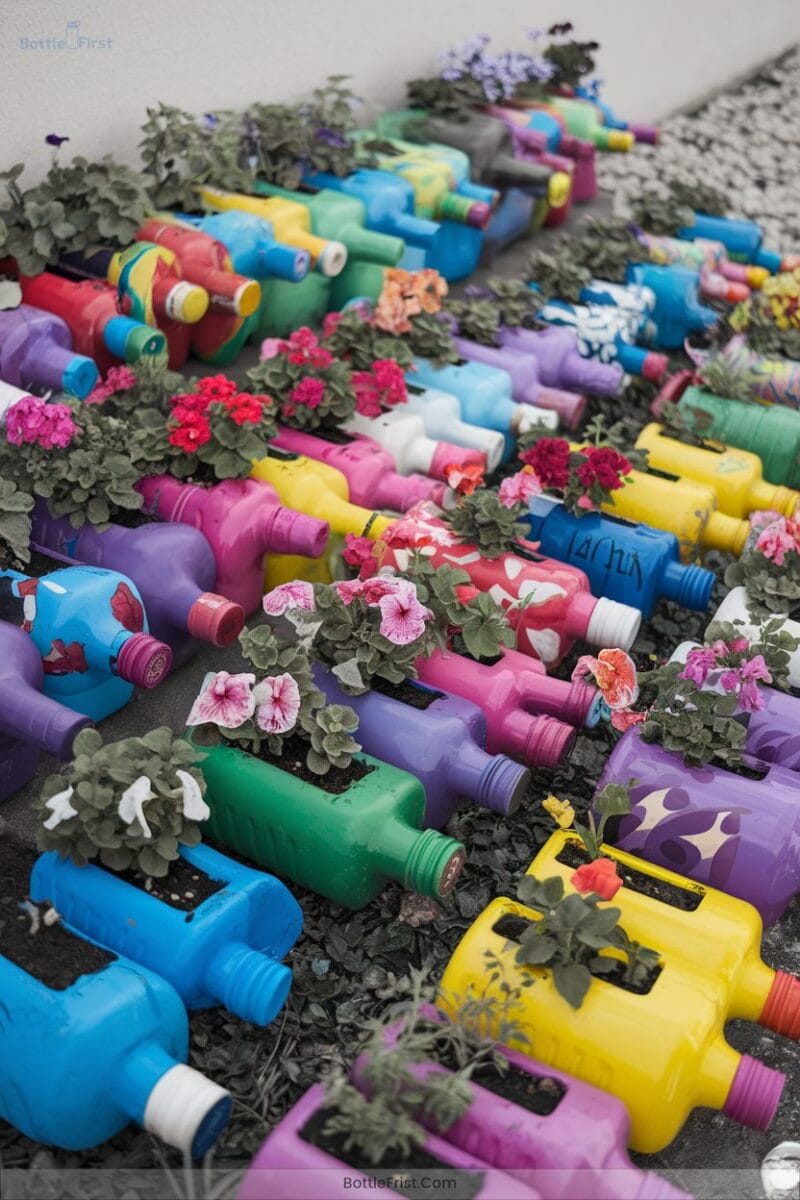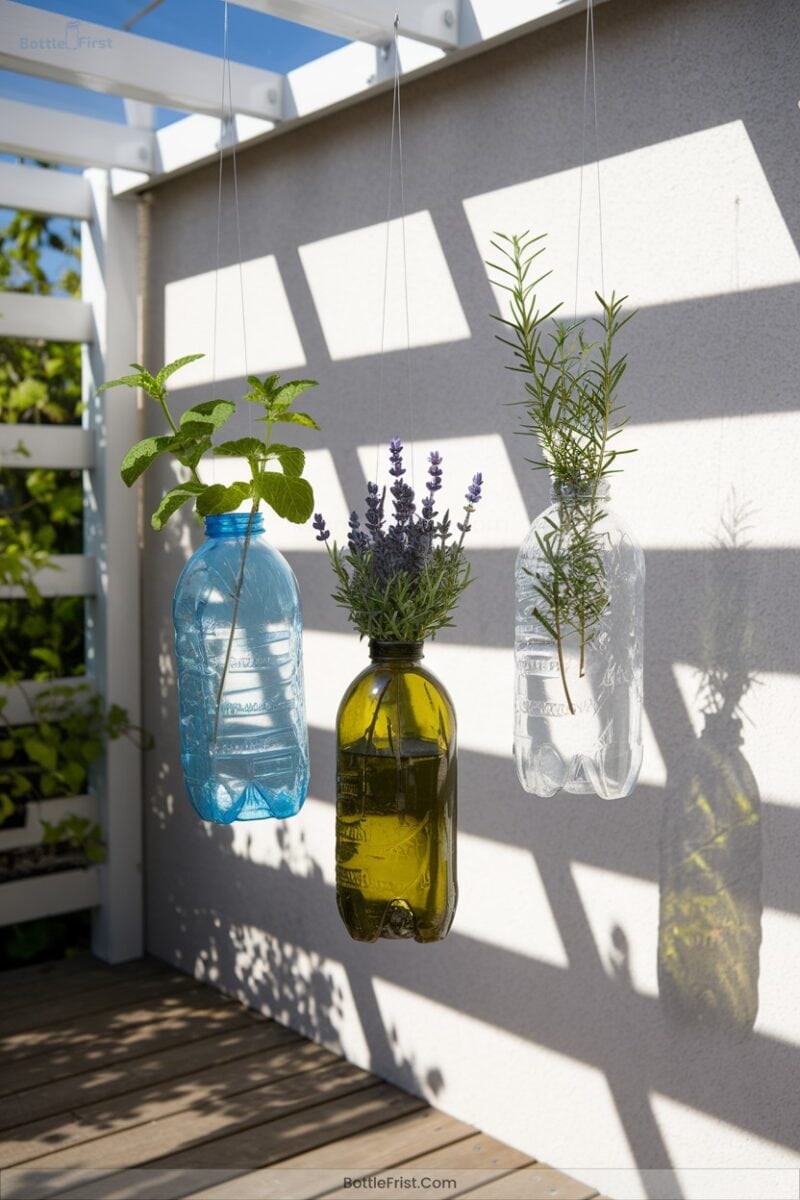14 Clever Plastic Bottle Garden Crafts to Beautify Your Outdoor Space
Transform your outdoor space using clever plastic bottle garden crafts. Craft self-watering herb planters by inverting bottles, or create a vertical herb garden system for efficient space use. Design DIY mini greenhouses from cut bottles for a warm microclimate.
Hang resilient succulent planters with drainage holes, or decorate with bottle terrariums. Discover versatile solutions like upcycled planter art or portable patio gardens. Explore these ideas for a beautiful, sustainable garden while embracing innovation.
1. Self-Watering Herb Planters
If you’re searching for a simple and efficient way to grow herbs at home, creating self-watering planters from plastic bottles is a fantastic option.
Begin by cutting flat-bottomed bottles, inverting the top into the base to form a reservoir. Drill a hole in the cap for the wick, which transfers water to the soil, ensuring consistent moisture.
Cover the top with mesh to prevent soil loss. Use duct tape for securing edges. This setup is perfect for single herbs like parsley or mint, thriving on kitchen windowsills.
Regularly check the water level, and enjoy fresh herbs at your fingertips.
2. Vertical Herb Garden System
When transforming your living space into a lush oasis, a vertical herb garden system crafted from plastic bottles offers both innovation and practicality.
Consider stacked towers with drilled holes for efficient water distribution and space savings. Hanging systems, supported by wires, let you suspend herbs from walls, perfect for small spaces.
Inverted bottle designs encourage upward growth, preserving soil and optimizing drainage. Opt for HDPE2 plastic for root safety and longevity, and use recycled additives like vermiculite to enhance drainage.
Modular layouts allow you to customize arrangements, while minimal footprint systems fit into urban gardens, maximizing your available space.
3. DIY Mini Greenhouses
Expanding your garden craft repertoire, DIY mini greenhouses made from plastic bottles offer a compact yet effective solution for nurturing seedlings.
Begin by cutting 2-liter bottles with scissors or a utility knife, guaranteeing maximum sunlight exposure. Add drain holes with a heated nail for proper water management.
Opt for netting to keep bugs away or plastic wrap to enhance condensation. Taper the tops over flames for snug fitting and reduced heat loss.
Plant seeds 1-2 cm deep in nutrient-rich soil, and maintain moisture with a spray bottle.
Position strategically for ideal sunlight and ventilation, creating a microclimate 4°F warmer.
4. Hanging Succulent Planters
Crafting hanging succulent planters from HDPE 2 plastic bottles is an inventive way to beautify your space while embracing sustainable practices.
Begin by cutting the bottles at the neck or midpoint for adequate planter depth. Use a pyrography pen or nail to create drainage holes, ensuring healthy root environments. Secure twine near the rims for easy hanging.
This method provides a low-cost, no-waste solution, ideal for balconies or small gardens. Choose resilient succulents like Aloe Vera or Echeveria, which thrive in compact spaces and require minimal water.
The UV-resistant bottles withstand harsh conditions, making them perfect for outdoor displays.
5. Bottle Terrariums
After transforming plastic bottles into hanging succulent planters, you can further explore their potential by creating bottle terrariums.
Start with a clean, dry 2L soda bottle, cutting it above the rubber band line. Layer the bottom with pebbles or sand for drainage, followed by a thin activated charcoal layer to fend off mold.
Add 2-3 inches of nutrient-rich potting soil, making holes for humidity-loving plants like Peperomia or Sedum. Seal the bottle with a flap or tape, misting occasionally.
Place near indirect sunlight for ideal growth. Incorporate nature-inspired decorations like moss or miniature structures for a unique touch.
6. Wall-Mounted Planter Array
When transforming your walls into a verdant display, consider crafting a wall-mounted planter array using everyday plastic bottles.
Start by cutting bottles horizontally to create half-barrel planters, ensuring space for soil and plants. Secure them to walls with screws or adhesive hangers, adding drainage holes to prevent root rot.
For a modern twist, design geometric patterns or stagger bottles at varied heights. Enhance these planters by painting them with weather-resistant acrylics or adding marbled effects.
Don’t forget to label each with chalk for a personalized touch.
This innovative approach breathes life into narrow corridors or balcony walls.
7. Tiered Bottle Garden
Transform your garden space with a tiered bottle garden that makes clever use of vertical space while showcasing your creativity.
Begin by selecting uniform 2-liter bottles, ensuring you remove labels and smooth edges for a polished look. To construct, cut below labels for stability and drill small drainage holes to prevent waterlogging. Use an inverted base bottle to anchor your tower. Space soil an inch below rims to manage overflow, and create access flaps for easy maintenance.
- Mix bottle sizes for architectural flair.
- Opt for clear bottles to boost light penetration.
- Sterilize bottles to safeguard against contamination.
Innovate your space sustainably!
8. Hydroponic Bottle System
If you’re looking to revolutionize your gardening approach, a hydroponic bottle system offers a sustainable and space-efficient alternative to traditional soil-based methods.
Start by preparing 2L plastic bottles as growth chambers, integrating a wick system with cotton yarn for nutrient delivery. Stack these vertically for a modular, scalable setup.
Monitor water quality with heat, EC, and pH sensors, guaranteeing ideal conditions. Automate irrigation with a gravity-fed drip system, efficiently using water and nutrients.
Regular maintenance, like nutrient top-ups and pH adjustments, guarantees robust plant growth.
This innovative system accelerates growth and maximizes space, transforming your gardening experience.
9. Decorative Plant Holders
Although gardening traditionally relies on the earth, decorative plant holders crafted from plastic bottles bring innovation and charm to your green space. Start by cleaning and cutting bottles to create open-mouthed planters.
Personalize them with a splash of color or texture using paint, stickers, or even fabric wraps. For added flair, try crafting macrame hangers to elevate and display your creations stylishly. This makes them perfect for growing herbs like basil or mint.
- Prepare bottles: Clean, cut, and decorate.
- Create macrame hangers: Use twine for structural support.
- Combine function and aesthetics: Mount bottles vertically on walls or fences.
10. Bottle-Based Seedling Starters
When it comes to starting seedlings, plastic bottles offer a versatile and efficient solution.
By cutting bottles, you can create simple seed starters or self-watering systems. Use the lower section as a container with drainage holes, and the upper part as a water reservoir.
Transform plastic bottles into seed starters by using the bottom for soil and the top for watering.
String or yarn wicks moisture from the bottom, keeping soil hydrated. Sterilize potting soil in the microwave to prevent mold.
For aesthetics, add scrapbook paper or paint. Compact and portable, these starters let you optimize sunlight exposure.
Remember to cover bottles in frost and transfer seedlings at 6-8 inches.
They’ll outgrow containers in 2-4 weeks.
11. Modular Plant Towers
Building on the idea of using plastic bottles for gardening, modular plant towers offer an innovative and efficient way to maximize vertical space.
Start by selecting discarded 2-liter bottles and other cylindrical containers. Transform these with basic tools: scissors, hammers, and nails. Cut bottle bases diagonally for secure vertical nailing.
Create a sturdy framework using wire grids or wooden supports, and enhance durability and aesthetics by spray painting the exteriors.
- Bottle Selection: Discarded 2-liter bottles, cylindrical containers.
- Tools Needed: Scissors, hammers, nails, wire grids.
- Construction Tips: Diagonal cuts, secure nailing, paint for protection.
Let creativity drive your garden’s vertical expansion!
12. Bottle Watering Devices
As you explore sustainable gardening solutions, bottle watering devices stand out for their simplicity and efficiency in maintaining plant hydration.
Opt for BPA-free bottles to protect edible plants from chemical leaching. Drill 10-15 small holes in the bottle’s lower half for a slow-release irrigation system, using a sock or nylon cover to prevent clogs. Regulate flow by adjusting the cap tightness.
For underground drip networks, bury bottles sideways to reduce evaporation. Inverted bottle watering with modified caps guarantees steady moisture for root-heavy plants.
Finally, create self-watering planters using split bottles with a cotton wick for consistent hydration.
13. Upcycled Planter Art
While exploring the creative potential of upcycled planter art, you’ll discover a world where sustainability meets personal expression.
By employing modular cutting techniques, you can tailor your planters to fit various plant species and maximize their growth potential. Ascertain healthy roots by implementing drainage through precise hole punching and maintaining airflow with ventilation windows.
Personalize your planters using aesthetic customization such as paint applications and etching. Consider plant choices that thrive in these innovative containers:
- Compact herbs like basil and mint
- Low-maintenance succulents such as aloe
- Trailing plants like ivy and air plants
Your creativity transforms plastic bottles into eco-friendly masterpieces.
14. Portable Patio Gardens
Transform your outdoor space into a sustainable haven with portable patio gardens that effortlessly combine practicality and innovation.
Embrace self-watering systems using 2-liter bottle reservoirs to maintain hydration without constant oversight. Harness attached dripper systems to minimize water waste, and explore pump-based hydroponic setups for automated care.
Utilize innovative self-watering setups and dripper systems for efficient, low-maintenance hydration in your portable patio garden.
Optimize vertical space with hanging plant racks from inverted bottles or create living walls using vertically arranged clusters. Move your gardens with ease using wheel-mounted stands, and try travel-friendly herb containers for freshness on the go.
With these solutions, you’ll maximize function and style while contributing to a greener, more efficient environment.
Frequently Asked Questions
How Do I Prevent Plastic Bottles From Degrading in Sunlight?
To prevent plastic bottles from degrading in sunlight, store them in shaded areas. Use UV-resistant coatings or wraps to block harmful rays. Implement creative solutions like using natural barriers or decorative covers for added protection and aesthetic appeal.
Are There Eco-Friendly Paint Options for Decorating Plastic Planters?
You can choose water-based acrylic paints with natural additives for durability or plant-derived options for non-toxicity. Make certain surfaces are clean, apply thin layers, and cure between coats for the best results on plastic planters.
Can These Bottle Crafts Withstand Strong Winds or Storms?
You can make bottle crafts withstand strong winds by using reinforced stitching, UV-resistant sprays, and heavy-duty fishing line. Ascertain you strategically place them in sheltered spots and use stainless steel fasteners for added durability.
What Are the Best Plants for Shaded Areas Using Bottle Planters?
You should choose Begonias, Coral Bells, or Hostas for shaded bottle planters. They thrive in low-light conditions, providing vibrant colors and lush foliage. Guarantee proper drainage and use organic soil to support healthy growth and long-lasting beauty.
How Do I Safely Cut Plastic Bottles Without Special Tools?
You’ve mastered the art of scoring with everyday tools. Forget fancy gadgets! Score with a utility knife, stabilize with household clamps, refine with scissors. Release innovation by transforming simple bottles into garden masterpieces with precise, safe cuts.
Conclusion
You’ve now got a toolbox of inventive ways to transform humble plastic bottles into vibrant garden treasures. Each project is a seed of creativity, ready to blossom into a lush tapestry of greenery.
As you commence on this journey, imagine your outdoor space as a blank canvas, waiting to be painted with the colors of sustainability and innovation. So, roll up your sleeves and let these ideas breathe new life into your garden, one bottle at a time.


